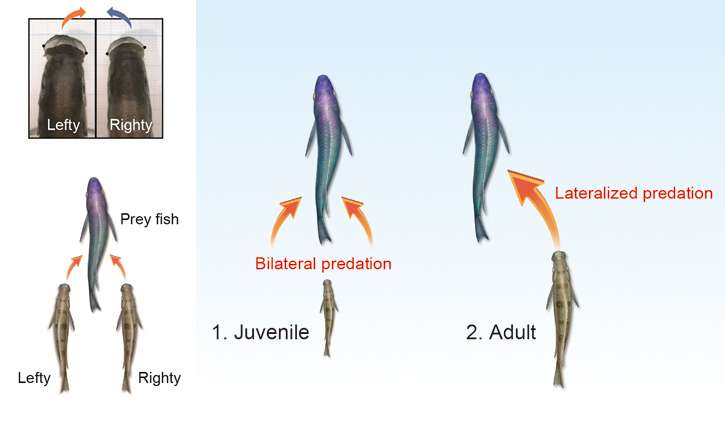Research team sheds light on 'rightie' or 'leftie' behavior in a scale-eating cichlid

Behavioral laterality, or left- or right-handedness, has been reported in many animals, including humans, chimpanzees, toads, rats, mice, and invertebrates such as crustaceans and insects. The existence of this phenomenon even in lower animals suggests it arose early in life's evolutionary history and that it confers survival advantages. However, exactly how it is acquired in the early life-stages is not known. A recent article in PLOS ONE reported how a team of Nagoya University-led researchers used a Tanganyikan scale-eating cichlid, Perissodus microlepis, as a model organism for behavioral laterality. The group discovered gradual acquisition of the trait during development as the fish learn the more effective side of their mouth for tearing off scales.
Scientists have long been aware of this phenomenon and documented its advantages in many animals. Greater adeptness at acquiring food clearly conveys an evolutionary advantage. While many such examples have been reported in the literature, the means by which left- or right-handedness is acquired during an animal's development, or if it is related to the asymmetrical processes of brain and organ development, have remained unclear.
By analyzing the stomach contents of scale-eating fish ranging from early juveniles to adults (covering various stages of development), the research team determined the proportion of scales from the left and right sides of prey fish in over 200 cichlids collected in the field. This allowed them to determine the age at which the fish transition from eating scales from both sides of their prey to preferentially attacking one side. Measurements of the lower jaw bone revealed a gradual increase in mouth asymmetry—i.e., skewed to the left or right—as the fish age.
"This is truly an important study because it allowed us to observe mouth direction development with age and the relationship between behavioral laterality and mouth asymmetry in these fish," says lead author Yuichi Takeuchi of Toyama University's Graduate School of Medicine and Pharmaceutical Sciences. "We can now also address the question of which came first, scale-eating or mouth asymmetry."
The direction of attack on prey depends on the individual fish's mouth asymmetry. Both "lefties" and "righties" exist in the species. Very young fish have slightly skewed mouths and feed on both sides of their prey, while older fish with more skewed mouths have a preferred attack side that matches their mouth asymmetry. Fish with more skewed mouths ate more scales, clearly indicating an advantage over their less skewed counterparts. This selection pressure is likely what drives young fish to adapt their feeding in accordance with the direction in which their mouth is skewed.
"Thus far, little is known about laterality of scale-eating cichlids in the developmental stage, other than for adults. We observed a gradual increase in mouth asymmetry toward the preferred side of attack as the fish aged," Takeuchi says. "This is exciting because it is the first documented evidence through field work on the development of behavioral laterality. We can conclude mouth asymmetry precedes behavioral acquisition. When considered in combination with the jawbone measurements, we point to the possibility that behavioral laterality, at least in this species, is a learned strategy that develops in association with morphology."
The genetic basis of mouth asymmetry has yet to be determined. Recently, researchers identified a relationship between the PCSK6 gene and dominant hand use in humans. This gene regulates the NODAL system, which is responsible for left-right asymmetry during embryonic development and is preserved in all vertebrates.
"Further physiological and genetic investigations may provide insights into neural mechanisms and underlying genetic bases of the lateralized behavior in vertebrates in general," says Yoichi Oda of Nagoya University's Graduate School of Science.
More information: Yuichi Takeuchi et al. Acquisition of Lateralized Predation Behavior Associated with Development of Mouth Asymmetry in a Lake Tanganyika Scale-Eating Cichlid Fish, PLOS ONE (2016). DOI: 10.1371/journal.pone.0147476
Journal information: PLoS ONE
Provided by Nagoya University


















